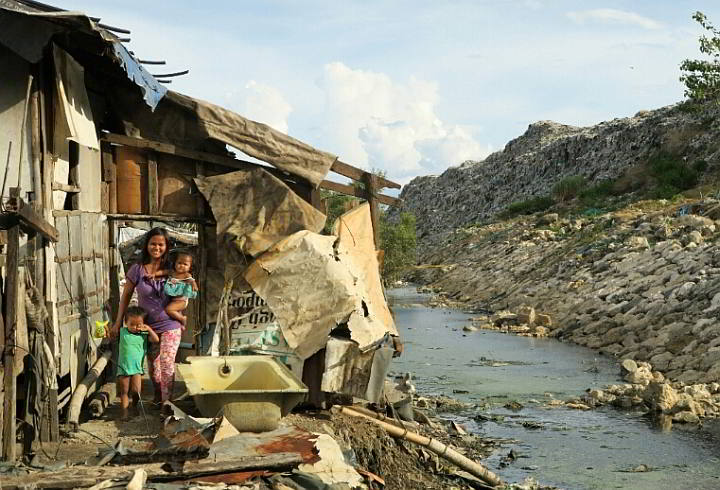Families living near Inayawan landfill at risk of a garbage landslide
HILLS OF TRASH
‘We’re not worried,’ says Inayawan landfill families of risk of a garbage landslide

Cerelyn Lapaz and children make do with shanty life in the Inayawan landfill where compacted garbage (right side) is part of the landscape.
(CDN PHOTO/TONEE DESPOJO)
More than 20 families living at the back of the Inayawan landfill are at risk of a “landslide” if towering mounds of garbage topple over, said barangay officials.
There’s a plan to relocate them to sitio San Isidro Labrador after the Cebu City government buys a 2.1-hectare lot.
“We don’t want to wait for an accident to happen. It’s better to relocate them to a safer area as soon as possible. The area is also difficult to reach because it’s at the back of the landfill,” said Inayawan barangay captain Lutherlee “Lotlot” Ignacio-Soon.
She said the risk became more apparent when the contractor of a seawall construction project at the back of the facility facing the South Road Properties (SRP) began removing large rocks from the base of the mountains of garbage.
The clearing work, which was not coordinated with the barangay, has been stopped but Soon said they still worry that the earth-moving work has compromised the stability of the piled garbage to the point of possible collapse.
Soon said she was told by Simeon Romarate, the disaster office executive director, that there was imminent danger to residents in the area.
The barangay requested an assessment and is waiting for feedback from the Cebu City Disaster Risk Reduction and Management Council (CCDRRMC).

Julieta Solit, 50, says she’s been living in the dumpsite for 35 years and has never experienced a “landslide” even if the garbage piles up behind her house like a small mountain. (CDN PHOTO/ TONEE DESPOJO)
Many residents in the landfill are construction workers and scavengers who pick through the trash for items to sell or recycle.
When Cebu Daily News visited the area yesterday, several residents said they didn’t feel their lives were in danger at all.
Julieta Solit, 54, said she prefers living in the site where she is a caretaker for a neighbor’s small piggery.
“Di man gyud mi mabalaka diri. Sa kadugay na nako nagpuyo diri, wala pa gyud na nidahili ang basura. Bisan kadtong kusog kaayo na linog pag October 2013, wala gyud naunsa,” she told CDN.
(We’re not worried here. We’ve been living here for the longest time. We’ve never experienced the trash collapsing. Even during the strong earthquake in 2013, nothing happened.)
Solit said she’s been living there since 1980 and can’t afford to build another home elsewhere.
But for barangay officials, prevention is better than dealing with an emergency.
“Right now they can’t see how dangerous the area is. But we don’t want to wait for something to happen before we act. In the end, it’s the barangay officials who get blamed if something bad happens,” said barangay captain Soon.
Some residents are open to being transferred as long as the relocation site is permanent and safer.
Lavinia Bayno, 28, lives in the dumpsite with her husband, a construction worker, and their three children. Their parents live across them in a small hut.
“Okay ra gyud namo pabalhinon mi kay lisod man gyud pud diri. Pero ayaw lang ng temporary. Okay rag mag-data-data mi basta permanent na imo kabalhinan,” Bayno told CDN.
(It’s okay if we are asked to transfer because it’s difficult here. But our relocation site should not just be temporary. It’s okay if we pay for it by installment as long as our relocation site is permanent.)
Her 75-year-old visually-impaired father Julian Bayno, 75, said they would consider moving out to another area as long as they don’t have to worry about being transferred again.
The city has a socialized housing program, and the dumpsite’s residents can be accommodated if they qualify as beneficiaries, said barangay captain Soon.
Of the 15-hectare landfill , 12 hectares are used as a garbage dumpsite.
It started operations in 1998 , costing Cebu city P300 million, and was filled to capacity after seven years.
Even after the Inayawan landfill was partially closed in December 2011, about 200 tons of waste were brought there daily for sorting, according to a study by the Japan International Cooperation Agency (Jica). City government estimates said it reached 400 tons a day.
READ: City Hall firm in closing down Inayawan landfill
Last January, Mayor Michael Rama ordered its total closure in order to comply with environment laws against the operation of open dumpsites.
Health risks are a serious matter to consider as well.

Piles of garbage at the Inayawan landfill. (CDN PHOTO/ TONEE DESPOJO)
Japanese consultants of Jica, which is completing a roadmap for Metro Cebu urban development, in its interim report last year, said there is a need to check the level of contamination of mercury in the soil, leachate, gas and sediments of the Inayawan that have built up after over two decades of garbage dumping.
Mercury, a toxic metal, originates from fluorescent bulbs and batteries which are discarded.
Mayor Rama, in his order closing the landfill said he wanted to rehabilitate it and make it a “productive, healthy, habitable and sustainable zone for economic development.”
The closure, long pressed by the Dept. of Environment and Natural Resources, is in compliance with provisions of Republic Act (RA) 9003 or the Ecological Solid Waste Management Act of 2000, the Philippine Clean Water Act of 2004 and Philippine Clean Air Act of 1999.
Disclaimer: The comments uploaded on this site do not necessarily represent or reflect the views of management and owner of Cebudailynews. We reserve the right to exclude comments that we deem to be inconsistent with our editorial standards.
